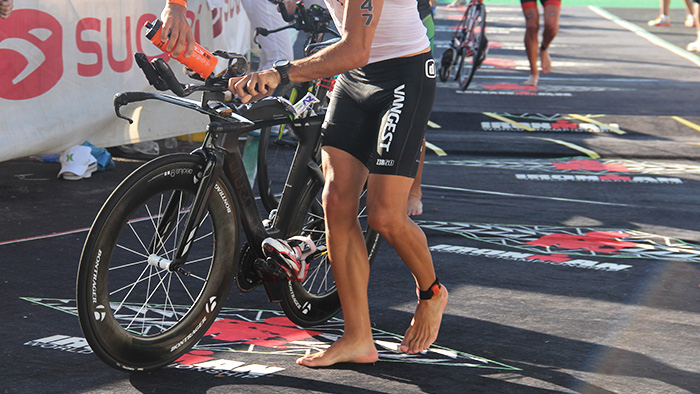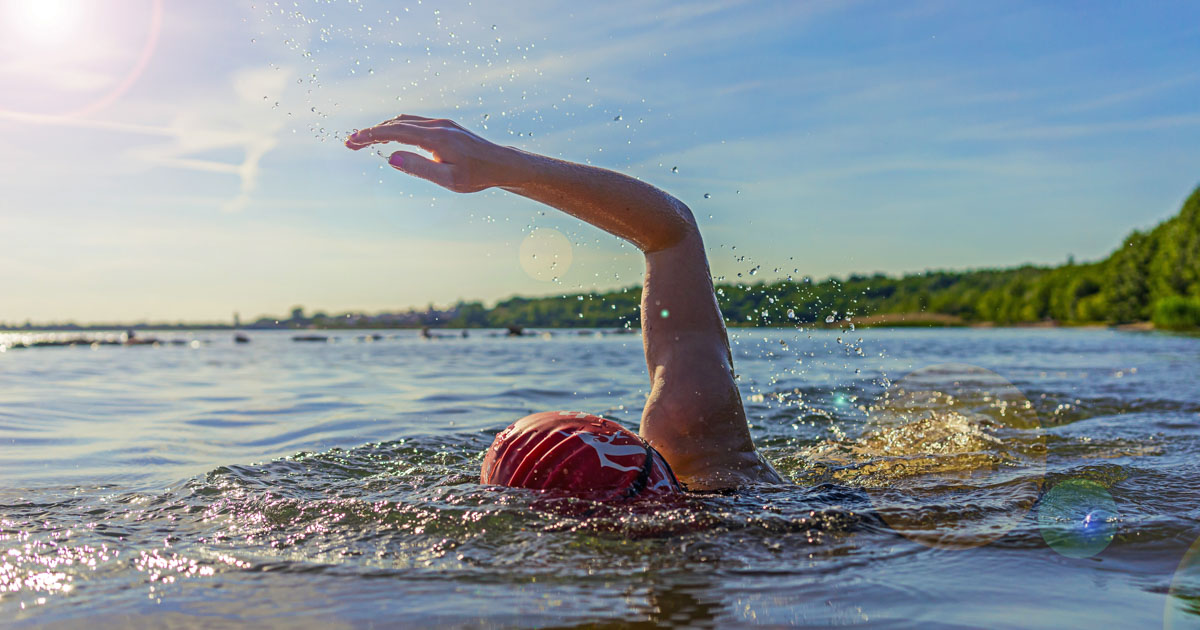So, you want to do your first IRONMAN? You are not alone—most single-discipline athletes such as runners, swimmers and cyclists are intrigued with the aspects of an IRONMAN training season, not to mention the allure of completing a 140.6-mile long event. As an IRONMAN athlete myself whose roots were set firmly in the sport of running, I can totally understand the curiosity of an IRONMAN event to a runner.
However, for many, it is hard to fully grasp what it takes to successfully train for and complete an IRONMAN event. As with all things worthwhile, it will not be easy, nor should it be. So expect and prepare yourself for the difficulties that are bound to come up. It will be an emotional and physical roller coaster with its own peaks and valleys. Chances are you will doubt yourself along the way. When this happens, take a deep breath, trust in yourself and keep your sights on the bigger picture: You will be an IRONMAN! Just be warned it will change your life forever!
Here is a look at the different things you can expect before, during and after your first IRONMAN experience.
Picking the Perfect Race
As you commence your IRONMAN journey you are immediately faced with a few critical decisions. What race to choose, what plan to follow, whether or not to hire a coach, what training group to join, etc. These are just the start and as you begin your research, you will find a ton of online information which can quickly become overwhelming. So, here’s a little advice: Think of the bigger picture, upcoming life events; vacations, kids, school, weather, work commitments, etc. Then be honest with how much time you can dedicate to training, carefully considering your family and work obligations.
The most successful athletes have the full support of their families. Make sure they understand that for the next few months, you will need their support to focus on training. With that said, make sure your training plan has some downtime that you can dedicate to your family. Think about the weather where you will be training and the weather at the race location when selecting an event. Work backward to find a race that will set you up for success during your training season. It’s less than pleasant to have to do a four-hour ride in the heat of the summer or to run three-plus hours in sub-freezing temperatures.
Race Budget
Be prepared to drop some cash. Race entry fees are about $600, and if you add in flights, hotel, transportation and gear shipping you’re easily hitting $2,000. All-in, you should allocate a total budget of about $3,000, depending on the location of the event.
Make sure you select a hotel close to the start/finish line. You’ll likely have to pay a premium, but it is worth it on race day. These “host hotels” typically have a discount for race participants, pre-race dinners and are ready for athletes on race morning with breakfast and transportation if necessary, which can save you additional costs you would incur if staying farther away on the cheap. Consider renting a car since you want to be off your feet as much as possible, and having your own wheels will keep you comfortable and minimize the stress of public transportation. Just remember to make sure the car is big enough to fit your bike and gear.
Some races have partnered up with companies who take care of bike and gear transport and it is definitely worth spending the money on this service. Once you arrive at the race, your bike and gear will be waiting for you and at the end of the event they will pick up your bike and gear and ship it back home. I strongly recommend this service. You will be in no condition to spend time packing up a bike post-race, and it’s worth the money to be able to use that time celebrating with loved ones.
Gear Budget
Triathlon is not a cheap sport so plan accordingly. Training gear, bike, nutrition, accessories, training races, wet suit and shoes are all things to budget for. Get quality gear as it will pay dividends in the future. Unfortunately, there are some things you might have to buy a few times until you learn what works best for you.
- Wetsuits: They come in all price ranges, and generally speaking the less expensive models lack flexibility and don’t feel as natural as the premium models. Fit is important, so don’t buy a wetsuit that doesn’t fit just because it’s cheaper.
- Bikes: Consider getting a used bike, but make sure you have an expert inspect it to ensure it is safe to ride and it is the right fit for you. You will be spending a lot of time on the bike, so it needs to be very comfortable and fit you well. A poor-fitting bike may even impact your running mechanics and eventually cause injuries.
- Gadgets: Save some cash by not investing in numerous gadgets in your first year of IRONMAN. Instead, focus on getting a feel for all three disciplines, it is easy to distract yourself with power meters, fancy heart rate monitors and sweet aero wheels. Keep it simple, you will have plenty of time to get all the toys next season. That being said, a power meter or a heart rate monitor can help your coach identify your training needs more efficiently and might help you pace better during the race, so if it is within your budget, consider investing in one or the other.
Race Goals
Race day goals should be simple for a first-timer: “Just finish and enjoy the race.” That’s it. You will learn so much while participating in your first event that the best thing to do is just take mental notes for the next IRONMAN event you do. IRONMAN is a totally different animal and even if you are a seasoned runner, set yourself up for success by limiting the expectations that you put on yourself.
You always want to leave your first event of any distance happy and energized to improve and continue with that distance. Creating too much pressure on your first event also takes so much of the fun and excitement of this new experience away from you. After your first event, your coach can work with you to set strategic goals based on your training and the outcome of the first to set realistic but challenging goals for the next one.
The Event
By now you have put in the months of necessary training, you have your nutrition dialed in and you are well-rested at the starting line waiting for the cannon to go off. At this moment all you can do is trust in your training, enjoy the day and take it all in. If things don’t go as planned, don’t panic. Adjust and adapt to the situation. Visualize the race ahead of time and plan for issues that might arise. This will help ease the mind a little in case your goggles break during your swim, or you get a flat and run out of air. You will have already planned for that situation and can handle it and move on without an issue. Remember, it’s a long day out there so one little obstacle shouldn’t make or break your race.
Swim
If you have a chance to warm up, take it. It is the perfect opportunity to do final adjustments to your gear and ensure your body is warm and ready for the swim. Once the race starts allow the masses to pass and settle into a comfortable pace. Be careful with swimmers around you who might inadvertently hit you (it happens, try not to take it personally).
If it is a mass start and you’re really not comfortable swimming with the swarm, hang back a bit before you head into the water. A few minutes after the start you will be able to get into a groove and follow the bubbles. Find a swimmer you can draft off of and stick with them to conserve energy. As they get tired take this opportunity to ensure you are going straight and find the next swimmer to draft behind. Always make sure you are breathing and relaxed.
Bike
Be smart on the bike. Conserve your energy, eat, hydrate and don’t overextend yourself. In every race we see athletes who are strong on the bike push themselves so hard that they have no choice but to walk the marathon, otherwise known as the “death march” or “IRONMAN shuffle.” This makes for a very long and agonizing day. So even if you are feeling amazing on the bike, take a step back and realize that you have a marathon coming up soon.
Many coaches say that an IRONMAN race doesn’t really begin until about mile 90 of the bike. Again, trust in your training. By race day you should have the appropriate miles under your belt, your nutrition plan should be keeping your energy levels up and you should be mentally ready for anything that might come up unexpectedly.
Run
Be smart and pace yourself. You will be tempted to leave the transition at a higher pace than you should. It is normal with all of the excitement and given that the legs have been used to the high cadence of the bike. This is the moment when it is critical to pace yourself.
Take the first few minutes to refuel and get your legs under you, as they might feel “noodly” for at least the first 5K. After that, settle into a comfortable pace but be ready for your body to start to feel uncomfortable. At this point, it has been a long day. Refocus on the task at hand, stay hydrated, don’t lose motivation and lean on your fellow athletes and supporters to energize you to the finish. Sometimes visualizing a different person or memory for each mile can help get you to that finish line.
Finish Line
The finish line of an IRONMAN event is indescribable. The energy and emotions will flood your body like nothing you’ve ever felt in your life. Enjoy this moment, this is what you have been preparing yourself for all of these months. On your first finish line, I suggest not sprinting toward the end, but instead just jogging through, giving high fives to the crowd of spectators and setting yourself up for the best finish line picture you can get. This is your moment, take it all in: YOU ARE AN IRONMAN!
Post Race
Now that are you a newly minted IRONMAN, now what? Well, first thing’s first. It’s time to recover, reward yourself and spend time with those special to you. You will find yourself hungry for more and you might have to fight back the temptation to immediately sign up for another event. The best way to avoid those crazy decisions made during a post-race high is to make them ahead of time. Or, at least have an idea of what might be next for you.
Spend some time with your coach during your taper to begin considering what’s next. That way once the race is over and you know if you want to take a little break from training or set a new time goal and sign up for the next race right away, you’ll have a plan and be making smart decisions.









